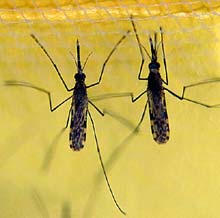Progress in probing the mosquito’s sense of smell

Male and female Anopheles mosquitoes <br>By Neil Brake, Vanderbilt University
Researchers find odorant in human sweat that attracts female mosquitoes
Today, we know a little bit more about one of mankind’s deadliest enemies, the mosquito. Scientists have taken an important step toward understanding the mosquito’s sense of smell, an avenue of research that may lead to better ways to repel the deadly insect.
In a joint effort reported in the Jan. 15 issue of the journal Nature, researchers at Vanderbilt and Yale universities have verified that the antennae of female Anopheles mosquitoes that prey on humans contain receptors that respond to one of the chemical compounds found in human sweat.
“This validates our hypothesis that the olfactory system of mosquitoes–and other insects–consists of an array of different receptors, each of which responds to a very narrow range of odorants,” says Laurence J. Zwiebel, associate professor of biological sciences at Vanderbilt, who participated in the study. His co-authors were Vanderbilt graduate student A. Nicole Fox along with Yale colleagues Elissa A. Halem, a graduate student, and professor John R. Carlson.
Confirmation of this hypothesis means that it should be possible to identify the specific human odorants and the protein receptors that allow female mosquitoes to identify their hosts when they need blood to satisfy their reproductive needs. In addition to cataloging the human odorants that attract mosquitoes, it also will allow the researchers to go further and search for additional chemicals that either attract or repel these highly selective insects.
“Looking at attractants is only half of the picture. There is no evidence that mosquitoes find some human odorants repellent, but we’re interested in exploring this,” says Zwiebel. Such discoveries might lead to new and more effective repellants that could play a major role in reducing the death toll from diseases spread by mosquitoes, including malaria, encephalitis, West Nile, dengue, hemorrhagic and yellow fevers.
Previous studies have shown that human sweat contains about 350 different aromatic compounds, but not much research has been done on them. For example, researchers do not know much about the individual variations in these odorants, not even how greatly the odorants of men and women differ.
However, recent data from researchers in the Netherlands suggests that mosquitoes use a blend of many odorants in targeting prey. “This is a very complex system,” Zwiebel observes.
The Nature paper reports another important advance. The researchers were able to get a mosquito olfactory gene to work in Drosophila, the fruit fly that has become the “white lab rat” of genetic research. This provides the researchers with a wealth of tools they can use to explore the nature of the mosquito’s olfactory system at the genetic and molecular level.
The researchers created fruit flies with Anopheles’ olfactory genes and then tested their sensitivity to different compounds found in human sweat. They identified one particular compound, 4-methylphenol, strongly activated an odorant receptor that is expressed in female mosquitoes but not in males. Previous studies had shown that the production of this protein is suppressed in female mosquitoes immediately following a blood meal when they are no longer responsive to human odors. The new finding strengthens the argument that female Anopheles use 4-methylphenol to seek out hosts.
The fact that the mosquito gene works properly in the fruit fly has another significant ramification. It means that the fundamental nature of the olfactory system in other insects must be extremely similar to that of the mosquito. “As a result, our research should have a direct bearing not only on the mosquito, but also on other insects that carry disease and act as agricultural pests,” Zwiebel says.
Media Contact
All latest news from the category: Life Sciences and Chemistry
Articles and reports from the Life Sciences and chemistry area deal with applied and basic research into modern biology, chemistry and human medicine.
Valuable information can be found on a range of life sciences fields including bacteriology, biochemistry, bionics, bioinformatics, biophysics, biotechnology, genetics, geobotany, human biology, marine biology, microbiology, molecular biology, cellular biology, zoology, bioinorganic chemistry, microchemistry and environmental chemistry.
Newest articles

Superradiant atoms could push the boundaries of how precisely time can be measured
Superradiant atoms can help us measure time more precisely than ever. In a new study, researchers from the University of Copenhagen present a new method for measuring the time interval,…

Ion thermoelectric conversion devices for near room temperature
The electrode sheet of the thermoelectric device consists of ionic hydrogel, which is sandwiched between the electrodes to form, and the Prussian blue on the electrode undergoes a redox reaction…

Zap Energy achieves 37-million-degree temperatures in a compact device
New publication reports record electron temperatures for a small-scale, sheared-flow-stabilized Z-pinch fusion device. In the nine decades since humans first produced fusion reactions, only a few fusion technologies have demonstrated…





















